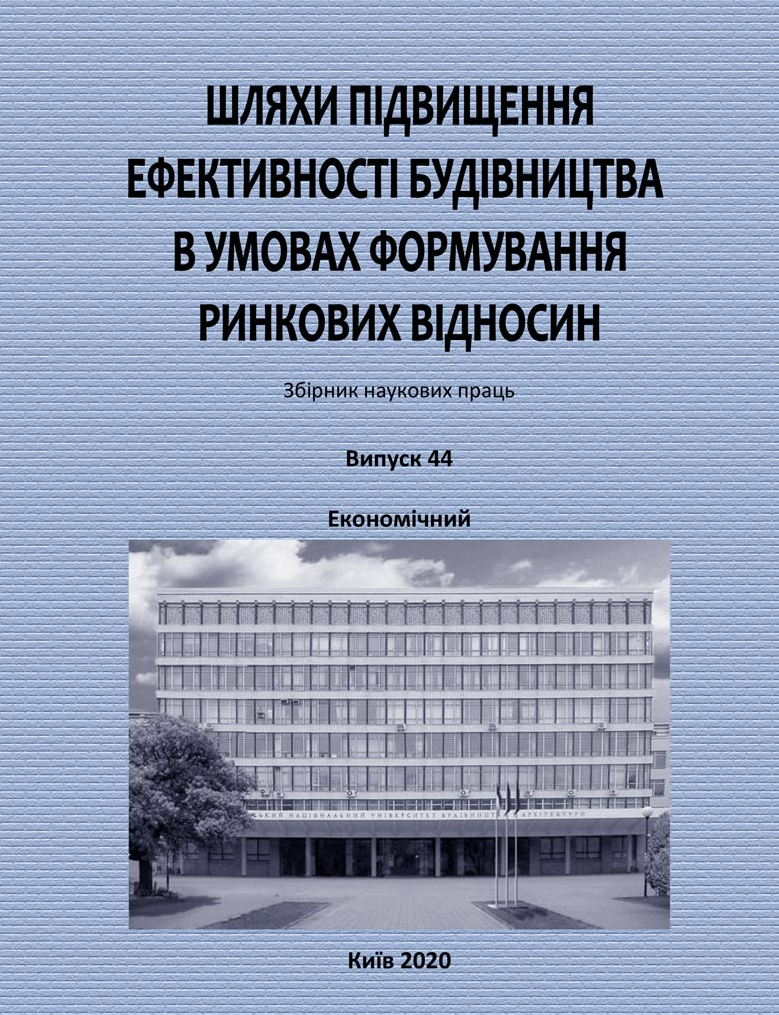Innovative technologies in construction
DOI:
https://doi.org/10.32347/2707-501x.2020.44.126-132Keywords:
innovation, technology, construction, activities, companiesAbstract
The article considers theoretical and practical bases of tendencies of development of construction market of Ukraine; determined that the directions of innovative business in construction are the following: a) the purchase of advanced foreign technologies and the organization of production of new products; b) purchase of progressive materials, machines and equipment for construction organizations; c) purchase of domestic and foreign patents for further organization of own production of building materials; d) services of foreign construction companies in the production of construction works using new technologies; e) conducting own R&D; f) implementation of own innovative architectural and design developments; g) training of workers and specialists in new technologies, skills in working with new mechanisms and building materials. Conclusions have been made about the need to introduce innovative technologies in construction; directions for stimulating the development of the construction market based on the introduction of innovative technologies are proposed. It is determined that in recent years there have been global changes in the main economic and production indicators of the external environment that affect the activity of construction enterprises. The most important of them are: complication of production; high requirements for quality of products and terms of delivery of products to customers; the emergence of individual requirements for products, which necessitated the transition to almost individual production with the whole complex of complex organizational and technical measures and system of reorganizations; increased competition.
It is substantiated that the implementation of the stated proposals for the activation of innovative activity in construction can serve as a certain impetus for accelerating the scientific and technological development of the domestic economy, the development not only of the construction market, but also the enhancement of Ukraine's competitiveness in the world market, which is especially relevant in modern conditions
References
Bondarenko Ye.V. Autsorsynh yak instrument upravlinnia efektyvnistiu diialnosti budivelnykh pidpryiemstv v umovakh vykhodu vitchyznianoi ekonomiky z kryzy [Elektronnyi resurs] / Ye.V. Bondarenko // Efektyvna ekonomika. – 2010. – № 3. – Rezhym dostupu: http://www.economy.nayka.com.ua/?op=1&z=1604.
Bubenko O.P. Innovatsiini skladovi pidvyshchennia efektyvnosti budivelnykh pidpryiemstv / O.P. Bubenko // BiznesInform. – 2012. – № 12. – S. 156-161.
Volk O.M. Problemy ta perspektyvy innovatsiinoi diialnosti u budivelnii haluzi Ukrainy / O.M. Volk, M.V. Shashko // Visnyk SumDU. – 2012. – № 1. – S. 115-121.
Musiienko P.V. Tekhnopark yak orhanizatsiina forma rozvytku innovatsiinoho potentsialu v Ukraini / P.V. Musiienko, A.H. Brazhnykova // Derzhava ta rehiony. – 2007. – № 3. – S. 154-157.
Smorzhaniuk T.P. Stalyi rozvytok v umovakh hlobalizatsii ta yoho skladovi / T.P. Smorzhaniuk // Ekonomichni innovatsii. – 2013. – Vyp. 53. – S. 253-260.
Tyshchenko O.M. Autsorsynh yak faktor efektyvnosti pidpryiemstv budivelnoi haluzi / O.M. Tyshchenko, V.Ie. Khaustova // Problemy ekonomiky. – 2012. – № 4. – S. 129-135.
Shkarlet S.M. Osoblyvosti funktsionuvannia ta rozvytku tekhnoparkiv v Ukraini / S.M. Shkarlet, L.A. Podymova // Problemy pidvyshchennia efektyvnosti infrastruktury. – 2011. – № 23. – S. 184-193.
Hoiko A.F.Marketynhovyi mekhanizm vzaiemodii vyshchykh navchalnykh zakladiv i pidpryiemstv: innovatsiinyi pidkhid / Hoiko A.F., Tuhai A.M., Yelishevych M.A. // Shliakhy pidvyshchennia efektyvnosti budivnytstva v umovakh formuvannia rynkovykh vidnosyn. – Vyp. 30. – K.: KNUBA, 2013.
Halunka O.D. Systema yakosti v vprovadzhenni innovatsii na budivelnomu pidpryiemstvi./ Halunka O.D., Hrytsenko O.S., Sultanov Z.H.O.// Mizhnarodna naukovo-praktychna konferentsiia «Ekonomiko-upravlinski ta informatsiino-analitychni novatsii v budivnytstvi»(23-24 travnia 2019 r., m. Kyiv). – Kyiv, Vydavnytstvo Lira-K, 2019.– 312 s. C/88-89.
Hryhorovskyi P. Ye. Organizational and technological model engineering in the construction industry : collective monograph/ P. Ye. Hryhorovskyi, S. P. Stetsenko, O. I. Menejljuk, A. S. Molodid, V. O. Khyzhniak, G. M. Ryzhakova. // – Lviv-Toruń : Liha-Pres, 2019. – 128 p.
Tugai O. A. Organizational and technological, economic quality control aspects in the construction industry : collective monograph/ O. A. Tugai, P. Ye. Hryhorovskyi, V. O. Khyzhniak, S. P. Stetsenko, O. Yu. Bielienkova, O. S. Molodid, D. Chernyshev.// – Lviv-Toruń : Liha-Pres, 2019. – 136 p.
Nikolaiev V. P. Technical and economic aspects of real estate properties : collective monograph / V. P. Nikolaiev, P. Ye. Hryhorovskyi, V. O. Khyzhniak, G. M. Ryzhakova, O. Yu. Bielienkova, O. S. Molodid. // – Lviv-Toruń : Liha-Pres, 2019. – 124
Downloads
How to Cite
Issue
Section
License
Copyright (c) 2020 D. Novikov, K. Lavrukhina, Ya. Kushik-Strelnikov

This work is licensed under a Creative Commons Attribution 4.0 International License.
Authors who publish with this journal agree to the following terms:
- Authors retain copyright and grant the journal right of first publication with the work simultaneously licensed under a Creative Commons Attribution License that allows others to share the work with an acknowledgement of the work's authorship and initial publication in this journal.
- Authors are able to enter into separate, additional contractual arrangements for the non-exclusive distribution of the journal's published version of the work (e.g., post it to an institutional repository or publish it in a book), with an acknowledgement of its initial publication in this journal.
- Authors are permitted and encouraged to post their work online (e.g., in institutional repositories or on their website) prior to and during the submission process, as it can lead to productive exchanges, as well as earlier and greater citation of published work (See The Effect of Open Access).

